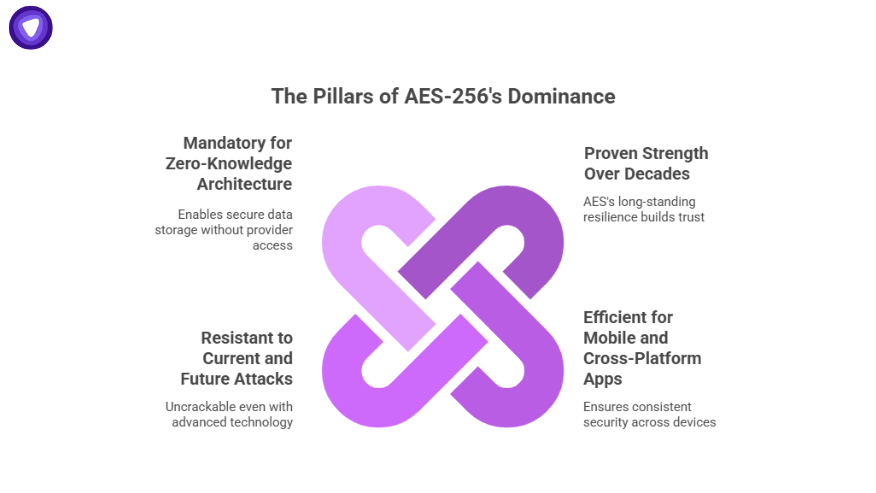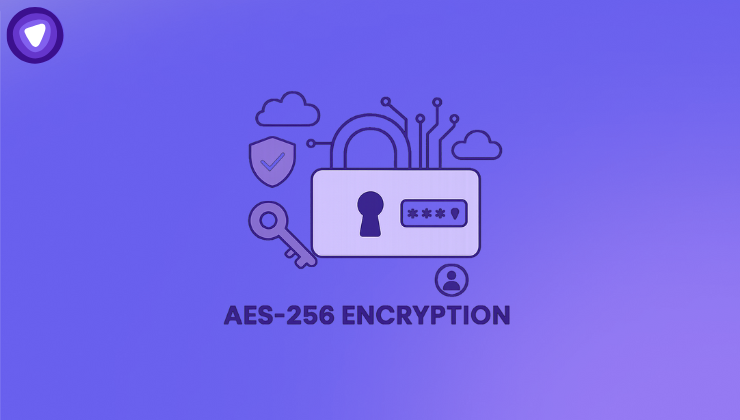- AES-256 Core: AES-256 encryption is the core technology behind modern password vaults, providing unmatched security and resistance to brute-force attacks.
- Multi-Level Protection: Password vaults use AES-256 at multiple levels including device encryption, individual password entries, local storage, cloud sync, and recovery processes.
- Multi-Platform & Family Use: Modern vaults are essential for multi-platform and family use, offering secure syncing, auto-fill, shared vaults, and individual access.
- Mobile-First Security: Mobile users benefit from AES-256 encryption with protection against device theft, compatibility with biometrics, and offline security.
- White-Label Advantage: White-label solutions like PureVPN White Label Password Manager leverage AES-256 to offer secure, zero-knowledge password management across platforms without building custom encryption infrastructure.
Most people do not think about encryption when saving a password, yet every secure digital action depends on it. Modern password vaults succeed only when their encryption standard stays strong, proven, and widely trusted. AES-256 fills this role with consistency, reliability, and resilience against modern cyber threats.
Its importance becomes clearer as password managers become essential for personal, professional, and family use. From individuals searching for the best free password manager to teams adopting the best password manager, AES-256 provides the mathematical shield that prevents attackers from turning stolen data into readable text.
How AES-256 Works Without the Complexity?
AES-256 is a symmetric encryption system. A single key encrypts the information and the same key decrypts it. The “256” refers to the key length: a 256-bit key creates 1.15 x 10⁷⁷ possible combinations. No existing computer, system, or adversary can brute-force a key of that size within any reasonable time frame.
That predictability matters because password vaults rely on repeatable encryption behavior. Users need secure access every time they sign in, but attackers must never decipher anything even if they somehow acquire encrypted vault data.
Why AES-256 Became the Standard for Modern Password Vaults

AES-256’s adoption as the encryption standard stems from a combination of proven reliability, efficiency, and security.
1. Proven Strength Over Decades
AES became the United States federal encryption standard in 2001. Two decades later, it remains unbroken. This long history builds trust for anyone choosing between the best modern password vaults.
2. Efficient for Mobile and Cross-Platform Apps
Phones, tablets, and desktops can all run AES-256 without performance problems. This ensures consistent security for the growing number of users interested in modern password vaults for Android and the best password manager for iPhone.
3. Resistant to Current and Future Attacks
Even with advanced hardware or distributed computing, AES-256 cannot be cracked through brute force. Research referenced in a 2024 cybersecurity performance study stated that a full AES-256 key search would require more energy than the planet can produce within a year, even with hypothetical specialized hardware.
4. Mandatory for Zero-Knowledge Architecture
Most secure vaults follow zero-knowledge principles. The provider cannot read your stored data. AES-256 forms the main protective layer that enables this model to function.
The Role of AES-256 in Password Vault Architecture

Understanding how AES-256 integrates into each layer of a password vault highlights its essential role in protecting user data.
Encryption at the Device Level
Passwords are encrypted on the user device before any sync occurs. Nothing reaches the cloud unencrypted.
Separate Keys for Vault Items
Each password entry can receive its own unique encryption key derived from the master key. This isolation prevents one compromised item from revealing another.
Integrity Checks
AES-256 supports authentication modes that verify whether stored data has been tampered with.
High-speed Operations
A secure password vault must feel fast. AES-256 supports rapid encryption and decryption cycles, giving users instant access without compromising safety.
Where AES-256 Operates Inside a Password Vault
The following table highlights the key areas within a password vault where AES-256 encryption ensures security and integrity.
| Vault Component | AES-256 Function | Why It Matters |
| Master Password Derivation | Converts user password to key material | Prevents weak passwords from becoming weak vaults |
| Password Entry Encryption | Protects each stored credential | Enables safe auto-login and sync |
| Local Storage Security | Encrypts files stored on devices | Essential for multi-device vaults |
| Sync With Cloud | Ensures encrypted data stays unreadable | Provider never sees raw data |
| Recovery Process | Verifies user identity securely | Prevents fraudulent access attempts |
AES-256 and the Real-World Need for Secure Password Vaults
Every major security incident highlights the increasing value of encrypted password storage. Attackers continue shifting toward credential theft because passwords still control access to banking, health records, business systems, and private communication.
A study from early 2025 found that users with access to a secure vault created 70 percent stronger unique passwords on average. These findings reinforce the need for modern password vaults that rely on AES-256 to prevent unauthorized access even during worst-case scenarios.
The Growing Demand for the Best Modern Password Vaults
Rising digital complexity has increased the need for password vaults that work across multiple platforms.
Multi-Platform Life
Users often operate across phones, laptops, browsers, and apps. Modern password vaults support:
- Secure syncing
- Instant autofill
- Encrypted storage
- Multi-device login
AES-256 handles the encryption layer across all systems without slowing performance.
Family Usage Is Rising
Search interest for the best password manager for families has increased steadily through 2024 and 2025. Families want:
- Shared vaults for streaming accounts
- Individual vaults for personal logins
- Safe recovery options
- Child or teen-friendly permission settings
All require encrypted boundaries powered by AES-256.
Tech-Savvy Users Demand Transparency
Communities like best password manager Reddit evaluate products on encryption standards, not just features. AES-256 consistently ranks high because it is widely studied, independently reviewed, and understood by professionals.
Why AES-256 Matters for Mobile-First Users?

Smartphones now serve as a primary authentication device for most people. That shift makes encryption quality even more important.
Protection Against Device Theft
If a phone is stolen or compromised, AES-256 keeps stored passwords unreadable without the master key.
Compatibility With Biometric Unlock
Biometrics authenticate the user, not the encryption. The vault still encrypts with AES-256 in the background.
Offline and Online Security
Even when offline, modern password vaults store encrypted data locally. When online, they sync securely.
This explains the rising demand for modern password vaults for Android and the best password manager for iPhone, especially among users who want simple access without losing security rigor.
Challenges Modern Password Vaults Still Need To Address

AES-256 protects stored data, but password vaults must solve additional problems:
- Preventing phishing
- Handling cross-device syncing securely
- Ensuring strong master passwords
- Providing secure recovery methods
- Supporting multiple user profiles
Encryption solves a core issue, but complete safety requires thoughtful design in every layer above it.
Where a White-Label Password Manager Fits Into This Landscape?
Organizations now want to distribute secure password tools under their own brand without building encryption architecture from scratch. AES-256 allows white-label solutions to offer enterprise-level protection while maintaining full brand control.
It also enables service providers, telecom companies, SaaS platforms, and cybersecurity firms to deliver password management within their ecosystem.
A white-label solution built around AES-256 gives partners predictable security, simple onboarding, and cross-platform support without needing internal cryptography teams.
How PureVPN White Label Password Manager Builds on AES-256
PureVPN White Label Password Manager uses AES-256 as its encryption foundation, maintaining a secure zero-knowledge environment for every stored credential. The architecture keeps data encrypted at every stage, including local storage, cloud sync, and device-level access. This structure supports multi-platform users and businesses seeking modern password vaults with consistent reliability.
The platform also provides branded experience options, allowing partners to offer secure password management to their customers without building new infrastructure. AES-256 ensures stored secrets remain protected even if devices are compromised or data sync traffic is intercepted.
Take Control of Your Password Security
Using strong, unique passwords for every account is essential. A password manager makes it effortless to generate, store, and autofill complex passwords—keeping you safe from breaches.
A Final Word on AES-256 and the Future of Modern Password Vaults
AES-256 remains the most practical and trusted encryption method for modern password vaults. Its strength, history, and efficiency align with the growing need for secure digital identity storage across individuals and businesses.
As cyber risks evolve, the combination of proven encryption and thoughtful vault design will determine which password managers remain dependable in real-world use.
Modern users want privacy, clarity, and consistency. AES-256 delivers all three, creating the foundation that every secure vault depends on today and in the years ahead.


